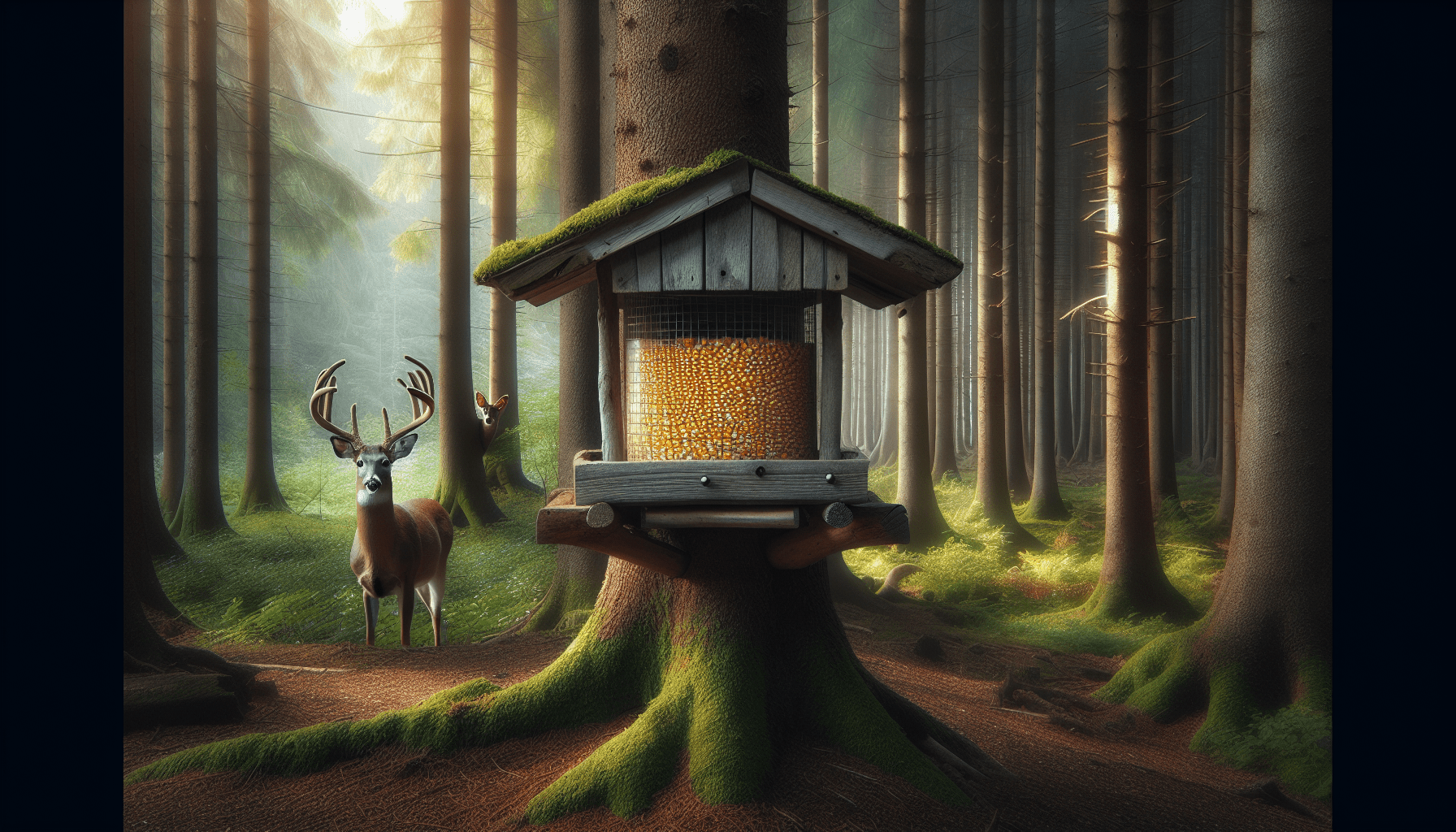
What if you could enhance your hunting success by using a tool that not only attracts deer but also provides insights into their behavior? The use of deer feeders is a strategy that many hunters employ to optimize their chances of making a successful harvest. Understanding how to effectively incorporate these feeders into your hunting regimen can significantly improve your results. Let’s dig into the nuances of using deer feeders as a hunting tool.
Understanding Deer Behavior
Before you take the plunge into using deer feeders, it’s essential to grasp the basics of deer behavior. Understanding how deer behave in their natural environment can help you figure out the best way to set up your feeders.
The Importance of Food Sources
Deer are herbivores that rely heavily on foraging to meet their dietary needs. In the wild, they tend to stick to areas where food is plentiful. Knowing what motivates deer to visit specific locations will help you choose the right spots for your feeders.
Seasonal Behavior Patterns
Deer behavior varies by season. During the fall, they focus on fattening up for winter. In the spring, they are often more curious and exploratory. Understanding these patterns allows you to adjust your feeder strategy accordingly.
Choosing the Right Deer Feeder
Selecting the right type of deer feeder is crucial. There’s a variety of options on the market, and each has its own advantages.
Types of Deer Feeders
| Feeder Type | Description | Pros | Cons |
|---|---|---|---|
| Gravity Feeders | Operate on a simple principle where grain falls from a hopper. | Low maintenance, less expensive | Limited capacity, may waste food |
| Broadcast Feeders | Disperse food on the ground using a motorized spinning mechanism. | Covers a wide area, attracts more deer | Requires more maintenance |
| Timer-Feeding Feeders | Distribute food at preset times throughout the day. | Consistent, mimics natural feeding times | Higher initial cost |
| Protein Feeders | Designed specifically to provide protein-rich food for deer. | Improves health, attracts deer consistently | More expensive, requires specific food |
Materials and Durability
When choosing a deer feeder, consider the materials. Look for feeders made of durable, weather-resistant materials to ensure they withstand the elements. Investing in a well-constructed feeder can save you from future headaches and additional expenses.
Size and Capacity
Think about how many deer you anticipate visiting the feeder. Larger, more durable feeders can handle more traffic and require less frequent refilling than smaller or less sturdy options.

Optimal Placement of Deer Feeders
Once you’ve secured the right feeder, the next step is figuring out where to place it. The location plays a significant role in how successful your feeding strategy will be.
Proximity to Deer Trails
Position your feeder near established deer trails. Deer tend to frequent paths that lead to and from food sources, so placing a feeder along these trails can maximize your chances of attracting them.
Distance from Bedding Areas
It’s also advisable to avoid placing feeders too close to deer bedding areas. If the feeders are too close to their resting spots, deer may feel threatened and avoid the area altogether. Aim for a moderate distance that allows deer to feel safe while still easily accessing food.
Consider Natural Cover
Surrounding your feeder with natural cover can provide deer with a sense of security. Using trees, bushes, or other natural barriers can create a more appealing feeding area, enhancing the likelihood of deer visiting the feeder.
Feeding Strategies for Success
With your feeder set up, now comes the tactical part. Implementing efficient feeding strategies can significantly enhance your hunting success.
Timing is Key
Deer are most active during dawn and dusk. Timing your feeder’s operation to coincide with these active periods can ensure deer will be present when you’re ready to hunt. Using timer-feeding feeders can help you automate this process.
Diversify Your Feed
Don’t limit yourself to just one type of feed. Diversifying your feed options can draw in different deer and increase your chances of capturing their attention. Consider incorporating grain mixes, protein pellets, and mineral supplements to attract a broader range of deer.
Monitor Deer Activity
Using trail cameras around your feeder can provide invaluable insight into deer behavior. Regular monitoring allows you to gauge how many deer are visiting, their feeding patterns, and any changes in their behavior based on time and environmental factors.

Legal Considerations for Using Feeders
Before you set up a deer feeder, ensure you understand the legal implications. Regulations can vary significantly by region and state.
Local Hunting Regulations
Always check with your local wildlife agency regarding laws and regulations governing deer feeders. Some states may have specific rules about the use of feeders, especially during hunting season.
Baiting vs. Feeding
In some jurisdictions, there’s a distinction made between baiting and feeding. Keep in mind that baiting can be illegal in certain areas during hunting season. Being aware of these laws can save you from potential fines or complications.
Evaluating the Effectiveness of Your Strategy
Once you’ve implemented your feeder, it’s crucial to evaluate its effectiveness regularly and make adjustments as needed.
Track Deer Patterns
Pay attention to the frequency of deer visits and their activity patterns. If you notice fewer visits than expected, consider changing your feeding strategy, location, or type of feed.
Adjusting Based on Seasons
Remember that deer behavior changes with the seasons. Be flexible and willing to adapt your feeding strategy. For instance, during the rut, deer may travel farther for mates, requiring you to reassess the location and the timing of your feeders.
Feedback from Your Hunting Experience
After hunting season, reflect on your experiences. Jot down notes on what worked and what didn’t. This reflection will assist you in optimizing your strategy for future seasons.
The Role of Technology in Enhancing Strategy
In our modern age, technology can be a great ally in your hunting efforts. Consider incorporating these tech tools to enhance your deer feeding strategy.
Trail Cameras
As mentioned earlier, trail cameras are an excellent resource for monitoring deer activity. They provide visual evidence of which deer frequent your feeder, assist in identifying mature bucks, and help you keep an eye on other wildlife that might be nearby.
Apps for Tracking
Several mobile applications allow you to track your feeding locations and monitor deer patterns over time. These apps can store valuable data, helping you make informed decisions about when and where to hunt.
GPS Devices
Using a GPS device or your smartphone can help you efficiently map out effective feeding and hunting locations. These devices can guide you back to your feeder site and help you avoid spooking deer during your approach.
Ethical Considerations and Best Practices
Hunting is not just about the thrill of the chase; it’s a responsibility that comes with ethical considerations. Being respectful to the wildlife and environment is crucial.
Food Waste Management
Always make it a priority to clean up any uneaten feed that may accumulate around your feeder. This helps prevent unnecessary waste and contributes to a healthier environment for the deer.
Respect for Wildlife
Be aware that your feeding practices impact not only deer but also other wildlife in the area. Ensure that you are not inadvertently harming other species or disrupting the local ecosystem.
Contribution to Conservation
By applying responsible hunting and feeding practices, you contribute to the larger conservation efforts for deer and their natural habitats. An ethical approach can enhance not only your hunting experience but also foster a more profound respect for nature.
Conclusion: Succeeding with Deer Feeders
Using deer feeders as a hunting tool can enhance your strategy and increase your chances of a successful hunt. By understanding deer behavior, choosing the right feeder, and employing effective feeding strategies, you place yourself in a more favorable position to succeed. Embrace technology, remain mindful of ethical considerations, and always stay informed about local regulations.
As you refine your hunting techniques, remember that the relationship between hunter and nature is one built on respect and understanding. Happy hunting, and may your next adventure be filled with the thrill of the chase!





